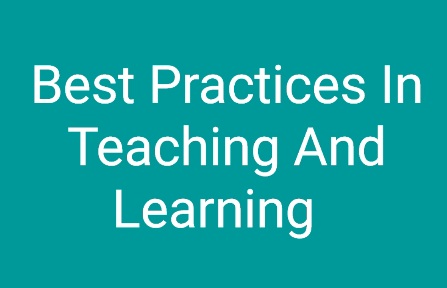Best practices in Teaching and Learning
Even after so much emphasis on innovative teaching methodologies, one can still walk into the typical Indian classroom and see it dominated by
- much teacher talk
- a focus on covering materials
- and a focus on covering materials without much regard to application,
- rewarding right answers and
- keeping the learner passive through much of the process.
Schools are still clinging to the factory model of organization, where each “worker ” is harnessed to a solitary spot -a desk bolted to the floor. Students continue to do much of their work alone.
In many classrooms, learning is often limited to memorization and practice of those concepts which we call “the basic skills ”.
The people running our country’s official education reform movement, that is politicians, state legislators, bureaucrats, and panels of businessmen, don’t know or care much about the structures of Best Practice education-workshop, integrative units, or collaborative learning.
Best learning practices
Student Feedback and remediation
Feedback is a fundamental tool of effective teaching and is a skill that, though easily learned, takes a lifetime to master
All kinds of learning require feedback based on formative assessments. Ironically, the quality feedback necessary to enhance learning is limited or nonexistent in many classrooms.
Also Read : How To Prepare Better For Half Yearly Exams?
To serve learning, feedback must meet four criteria:
- It must be, timely, specific, understandable to the receiver, and formed to allow for self-adjustment on the student’s part (Wiggins, 1998). Waiting three weeks to find out how you did on a test will not help your learning.
- In addition, specificity is key to helping students understand both their strengths and the areas in which they can improve. Too many educators consider grades and scores as feedback when, in fact, they fail the specificity test. Pinning a letter (B-) or a number (82%) on a student’s work is no more helpful than such comments as “Nice job” or “You can do better.” Although good grades and positive remarks may feel good, they do not advance learning.
- Can learners tell specifically from the given feedback what they have done well and what they could do next time to improve? If not, then the feedback is not specific or understandable enough for the learner.
- Finally, the learner needs opportunities to act on the feedback—to refine, revise, practice, and retry.
Remediation imparts information that can change the trajectory of a learner’s academic progress. Feedback is both the valuable information and the complex process that can help learners improve their performance. A teacher can make a marked difference in a child’s learning ability by using formative assessment as diagnostic test and on the base of it coming up with effective remediation which can be in the form of extra classes, specially designed homework /assignments, specific notes etc.
Teacher Education and In-service Training
“A teacher can never truly teach unless he is still learning himself. A lamp can never light another lamp unless it continues to burn its own flame.”-R.N. Tagore.
When the teachers meet in seminars or workshops, they develop a sense of security; a like- mindedness, a team spirit and a feeling of belongingness. So, in toto, the teachers get a training in democratic way of living.
To sum up all the above needs and importance of in-service teacher training, let us repeat what was stated by the Ministry of Education in England which holds good even today in our country. “The hall mark of a good teacher is that he is himself always learning and always developing his knowledge and understanding of children and young people.
In short, a teacher-should he a person who, because of his attitude to knowledge, to ideas in education, to his fellows and to life generally is better educated today than he was yesterday and will; tomorrow better educated than he is today.

